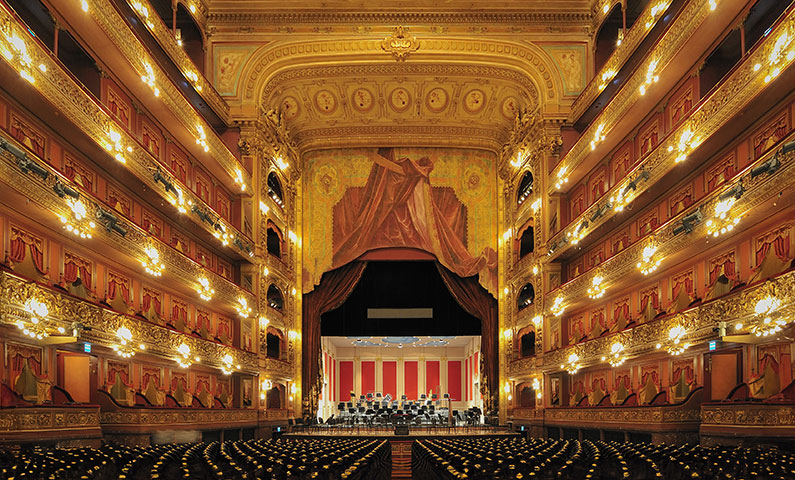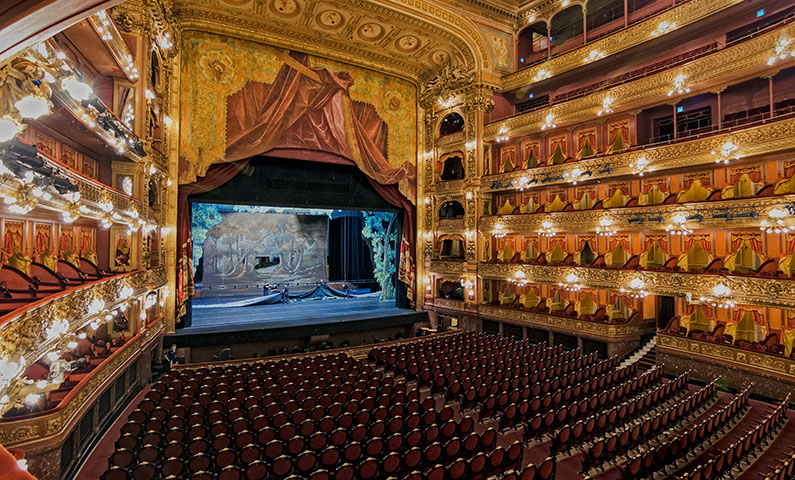With more than a century of existence, it is considered one of the most important lyric theatres in the world. The performance of the most prestigious artists, as well as beautiful acoustics and architecture, will leave you breathless.
The Colón Theatre in Buenos Aires is recognised as one of the five best opera theatres in the world for its acoustics and the artistic value of its construction Its current building turned 110 years old in 2018 and, although it was originally an exclusive theatre for opera, today it also hosts symphonic concerts and classical dance companies.
Throughout its history, the most outstanding personalities in the last century have been on stage. Respected figures such as Enrico Caruso, Maria Callas, Luciano Pavarotti, Vaslav Nijinski, Paloma Herrera, Rudolf Nureyev, Julio Bocca and Mikhail Barishnikov have been part of the Colón Theatre and left their mark in the house.

The grand auditorium of the Teatro Colón – Photo shutterstock.com
Being funded as a large-scale project that guaranteed a unique experience in terms of acoustics and visuals, it also aimed to be a venue for opera shows and various types of productions. For that reason, a multidisciplinary workshop was created in its basement.
Let’s explore the characteristics that make this theatre one of the best in the world.
History and Architecture
From 1857 to 1888, as an institution, the theatre operated in Plaza de Mayo. At that time, it was closed for the construction of a new hall. The opening night was on May 25, 1908, with the performance of Opera Aida, after 20 years of work.
In its beginnings, the Colón hired foreign companies. But it was from 1925 onwards that it had its stable staff orchestra, ballet and choir as well as its production workroom. This allowed it, in the 1930s, to present locally financed seasons supported by the city authorities. Since then, the Colón Theatre has been defined as a seasonal theatre or stagione recognised by the excellence and professionalism of specialised technicians and workers.
Colón Theatre at the end of the 19th century and the beginning of the 20th century eclectic period is the work of architects Francesco Tamburini, Vittorio Meano and Jules Dormal.
The building covers 8,202 square metres, of which 5,006 correspond to the central building and 3,196 to rooms below the level of the Arturo Toscanini passage (next to the theatre structure, parallel to Viamonte Street). The total covered area of the old edifice is 37,884 square metres. The expansions carried out later added 12,000 square metres, bringing the total area of the Colón Theatre to 58,000 square metres.
The main hall, in the shape of a horseshoe, meets the most severe standards of classical Italian and French theatre. This is 29.25 metres in smaller diameter, 32.65 metres in larger diameter and 28 metres high. The floor is lined with boxes up to the third floor and has a total capacity of 2,478 seats, although there is also a capacity for around 500 people standing. The 318-square-metre dome had paintings by Marcel Jambon, which deteriorated in the 1930s. In the 1960s, it was decided to restore it, and the work was commissioned to the Argentine painter Raúl Soldi, who was responsible for the inauguration in 1966.
The stage inclines three centimetres per metre and is 35.25 metres wide by 34.50 metres deep, and 48 metres high. It has a 20.30-meter-diameter rotating disc that can be electrically operated to rotate in any direction and quickly change scenes. In 1988, work was carried out to modernise the stage grid machinery to facilitate the management of the sets and speed up scene changes.
120 musicians can play in the orchestra pit, which is structured with a resonance chamber and special sound reflection curves. These conditions, the architectural proportions of the hall and the quality of the materials contribute to the Colón Theatre’s exceptional acoustics, recognised worldwide as one of the most excellent auditoriums.

Impressive hall of the Colón Theatre. Photo: shutterstock.com
The façade of the building is divided into sectors: the lower or base, 8.50 metres high; the middle one, 9.20 metres, and the upper one, 5.50 metres. The upper part of the building ends in a gable roof.
As an evocation of the Italian Renaissance, you can see columns with Ionic and Corinthian capitals, simple bases and arches, mouldings and architraves in the openings.
One of the most important aspects of theatre was the acoustics, which were considered perfect for lyrical singing. The Colón Theatre has a competitive advantage to be a reference centre on the international opera circuit since it has the best acoustic design in the world for opera performances. The horseshoe shape of the room distributes the sound while the use of fabric and wood helps to absorb it. On the four upper levels, hard materials such as marble have been used to create reverberation, offering a unique experience.
Colón Theatre Production Sector
The Colón Theatre performs the productions of its shows in its workshops located in the basement. In 1938, the basements under the side plaza on Arturo Toscanini were expanded by a tunnel connecting the production workshops. It was during that year that the Machinery, Scenography, Props, Tailoring, Shoemaking, Upholstery, Stage Mechanics, Sculpture, Photography, Makeup and Hairdressing workshops were enabled.
In 1963, the prop and costume painting workroom was created. According to the project of the architect Mario Roberto Álvarez, the second phase of the construction was under the plaza and Cerrito Street, from 1968 to 1972. This is where the theatre production sectors, scenographic workshops, rehearsal rooms, administrative offices and a staff dining room are located.
Later, the technical section of Production Design and the workshops of Lighting Engineering, Electromechanical Special Effects and Audio and Video were incorporated. In 2000, the City government, through the Department of Cultural Heritage, convened the General Administration of Infrastructure to elaborate a “Master Plan” for the enhancement of the building and technological updating of the stage box.
Artists Who Have Stepped on the Colón Theatre Stage
The number of great artists who performed at the Colón Theatre, from its inauguration to the present time, is immense. It means great significance in the great musical tradition and prestige recognised throughout the world. Composers such as Richard Strauss, Arthur Honegger, Igor Stravinsky, Paul Hindemith, Camille Saint-Saëns, Manuel de Falla, Aaron Copland, Krzysztof Penderecki, Gian-Carlo Menotti, Héctor Panizza, Juan José Castro, Gerardo Gandini and Mauricio Kagel are part of the theatre’s history.
Conductors of different generations appeared in this hall, such as Arthur Toscanini, Erich Kleiber, Fritz Busch, Ernest Ansermet, Wilhelm Furtwängler, Herbert von Karajan, Tulio Serafin, Leonard Bernstein, Mstislav Rostropovich, Karl Böhm, Fernando Previtali, Lorin Maazel, Bernard Haitink, Zubin Mehta, Riccardo Muti, Kurt Masur, Michel Corboz, Riccardo Chailly, Simon Rattle, Claudio Abbado, Rene Jacobs and Argentines Daniel Barenboim, Gabriel Garrido and Miguel Angel Veltri, among others.
Singers that we can mention from the extensive list are the tenors Enrico Caruso, Beniamino Gigli, Lauritz Melchior, Mario del Monaco, Richard Tucker, Wolfgang Windgassen, Alfredo Kraus, Plácido Domingo, José Carreras and Luciano Pavarotti; the sopranos Claudia Muzio, Lily Pons, Maria Callas, Renata Tebaldi, Kirsten Flagstad, Victoria de los Ángeles, Joan Sutherland, Birgit Nilsson, Montserrat Caballé, Eva Marton, Kiri Te Kanawa, Katia Ricciarelli, Mirella Freni, June Anderson and Renée Fleming; mezzo-sopranos Fedora Barbieri, Marilyn Horne, Teresa Berganza, Christa Ludwig, Régine Crespin, Frederica von Stade, Waltraud Meier and Cecilia Bartoli; baritones Titta Ruffo, Leonard Warren, Hans Hotter Cornell MacNeil, Hermann Prey, Sherrill Milnes, José van Dam, Dmitri Hvorostovsky; and the bass singers Fiodor Chaliapin, Borís Christoff, Ferruccio Furlanetto and Samuel Ramey.
Argentine artists of The Colón Theatre have developed important international careers: Delia Rigal, Luis Lima, Raul Gimenez, Ana Maria Gonzalez, Renato Cesari, Ricardo Cassinelli, Gian-Piero Mastromei, Angel Mattiello, Carlo Cossutta, Carlos Guichandut, Cecilia Diaz, Paula Almerares, Marcelo Alvarez, Jose Cura, Dario Volonte and Virginia Tola.
Anna Pavlova, Vaslav Nijinsky, Rudolf Nureyev, Alicia Alonso, Maia Plissetskaya, Margot Fonteyn, Mijail Barishnikov, Vladimir Vassiliev, Antonio Gades and the Argentines Maria Ruanova and Olga Ferri, Michel Borovsky, Jose Neglia, Norma Fontenla, Wasil Tupin, Emerald Agloglia, Jorge Donn, Julius Bocca, Maximilian War and Paloma Herrera are some of the first dance figures who have performed in the house.
During the lyrical seasons, prestigious managers like Ernst Poettgen, Margaret Wallmann, Otto Erhart, Cecilius Madanes, Robert Oswald, George Lavelli, Gilbert Defló, Nicolas Joel, Pier Luigi Pizzi and Hugo de Ana, alongside outstanding set designers and figures such as Nicolas Benois, Paul Walter, Hannibal Lapiz, Joseph Luciano Varona, Raul Soldi, Guillermo Roux, Ezio Frigerio, Franca Squarciapino and Graciela Galan, were part of the high points of the Colon’s history.
The world’s main orchestras have also performed at the Colón Theatre: the Vienna Philharmonic, the Philadelphia Symphony, the New York Symphony, the Berlin Philharmonic and the London Philharmonia. Likewise, outstanding instrumental soloists have shone on stage, some of the names are Martha Argerich, Alfred Brendel, Paco De Lucía, Antonio De Raco, Nelson Freire, Bruno Gelber, Friedrich Gulda, Gidon Kremer, Alberto Lysy, David Oistrakh, Manuel Rego, Narciso Yepes, Itzhak Perlman, Midori, Yo-Yo Ma, Pinchas Zukerman, Mstislav Rostropovich, Ralph Votapek and Misha Maiski, among many others.
Extensive Renovations
In 2008, the City Government began an in-depth restoration, with the aim of returning the Colón Theatre to all its splendour and, in addition, providing it with the most important technological advances. The reopening took place during the celebrations of the National Bicentennial, in 2010.
Currently, the building also houses different workshops where the productions of its shows are carried out, as well as the Higher Institute of Art, recognised worldwide and where future lyrical singers and dancers are trained.
At the box office or on the theatre’s website, you can get tickets to take a guided tour of the facilities.
Guided Tours
Guided tours can be taken inside the Colón Theatre without any inconvenience. Here we will give you some useful information.
The visits take place every day and last approximately 50 minutes, beginning at 11 in the morning every 15 minutes. The last tour is usually at 4:45 p.m. There are also two daily tours in English: 1 and 3 p.m.
The tour takes you through the Main Hall (stalls or boxes), the Main Foyer, the Bust Gallery and the Golden Hall. Visitors will learn amazing details about the architecture, the stairs, its sculptures or stained glass.
Rates depend on different factors. Tickets for disabled people with a companion, retirees, cultural passes and resident students can only be purchased at the theatre box office by presenting the corresponding certificate.
General tickets can be purchased online through the Colón Theatre website and at its box office, located at Tucumán 1171 from Monday to Saturday from 9 a.m. to 8 p.m. and Sundays from 9 a.m. to 5 p.m. Payment methods are cash, credit card and debit card.
A Prestigious Monument to Argentine Culture
The Colón Theatre is one of the must-sees in the world of opera. Its rich and prestigious history, together with the exceptional acoustic and architectural conditions of the building, put the place up to the standard of Scala in Milan, the Garnier Opera in Paris, the Vienna Opera, the Royal Opera House in London and the Metropolitan in NY.
Cerrito, 628, San Nicolás